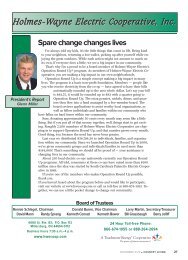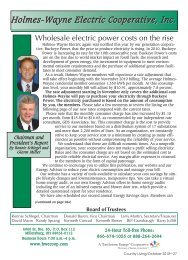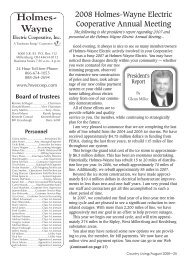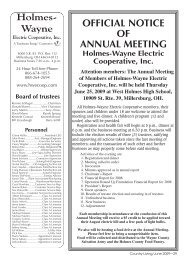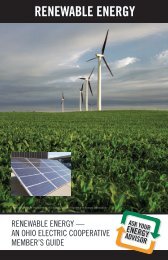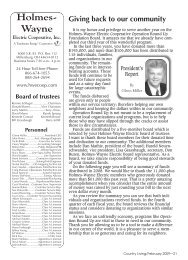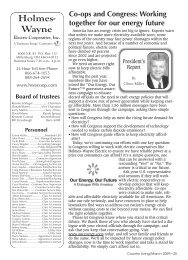November - Holmes-Wayne Electric Cooperative, Inc.
November - Holmes-Wayne Electric Cooperative, Inc.
November - Holmes-Wayne Electric Cooperative, Inc.
Create successful ePaper yourself
Turn your PDF publications into a flip-book with our unique Google optimized e-Paper software.
<strong>Holmes</strong>-<br />
<strong>Wayne</strong><br />
<strong>Electric</strong> <strong>Cooperative</strong>, <strong>Inc</strong>.<br />
6060 S.R. 83 P.O. Box 112<br />
Millersburg, OH 44654-0112<br />
Business hours 7:30 a.m.- 4 p.m.<br />
24 Hour Toll-free Phone:<br />
866-674-1055<br />
888-264-2694<br />
www.hwecoop.com<br />
Board of trustees<br />
Ronnie Schlegel ..................Chairman<br />
Donald Buren..............Vice Chairman<br />
Larry Martin .....................Secy.-Treas.<br />
David Mann<br />
Randy Sprang<br />
Kenneth Conrad Kenneth Bower<br />
Bill Grassbaugh Barry Jolliff<br />
Personnel<br />
Glenn Miller........................President/CEO<br />
John Porter.............Asst. Manager/Engineer<br />
Vicki Bilek....................Executive Secretary<br />
Casey Wagner............Accounting Manager<br />
Robyn Tate ..................Public Relations/HR<br />
Lisa Baker .......................Billing Supervisor<br />
Stacy Shaw.........Line Supv./Safety Director<br />
Ward Vaughn .....................Line Supervisor<br />
Brent Schrock ...........Contractor Supervisor<br />
Tim Vickers ..............Staking/Field Engineer<br />
Nolan Hartzler .....GIS Mapping Technician<br />
Gary Snyder....Operations Field Technician<br />
Craig Duncan .Operations Field Technician<br />
Brian Spencer ...................System Engineer<br />
Kenny DePriest....................Energy Advisor<br />
Karen Tish......Plant Accountant/Purchasing<br />
Curtis Woods............Warehouse/Mechanic<br />
Carol Hawkins...Customer Serv. Supervisor<br />
Jeanne Baker ...........Customer Service Rep.<br />
Sue Holcomb..........Customer Service Rep.<br />
Lisa Gress.....Customer Service/Accounting<br />
Albert Schonauer..............Class A Lineman<br />
Daryl Reynolds.................Class A Lineman<br />
Harry Morris.....................Class A Lineman<br />
Steve James ......................Class A Lineman<br />
Fred Combs ......................Class A Lineman<br />
James Rose .......................Class A Lineman<br />
Michael Maurer................Class A Lineman<br />
Michael Martin.................Class A Lineman<br />
Gregory Lemon ................Class A Lineman<br />
Michael Rowe ..................Class A Lineman<br />
Bowe Firebaugh ...............Class A Lineman<br />
Jeffrey Young.....................Class A Lineman<br />
Ed Walton.................................Utility Man<br />
Rick Fox ...................................Utility Man<br />
Darin Stefano..............Apprentice Lineman<br />
Steve Asbury...............Apprentice Lineman<br />
Josh Johnson ...............Apprentice Lineman<br />
<strong>Cooperative</strong> vision<br />
Predicting the future is difficult or next to impossible. That’s<br />
because there are so many variables beyond the knowledge and,<br />
yes, imagination of the human mind.<br />
In 1998, Google, <strong>Inc</strong>. was conceived in the Stanford University<br />
dorm room of two graduate students. No one predicted that by<br />
2008, just one decade later,<br />
Google would be the Internet’s<br />
most widely accepted search<br />
President’s<br />
Report<br />
By<br />
Glenn Miller<br />
engine.<br />
Google’s incredible growth<br />
came to mind recently when I<br />
learned its founders were<br />
investing $10 million in the<br />
development of plug-in hybrid<br />
electric vehicles (another<br />
innovation not predicted 10<br />
years ago).<br />
As the electric utility industry<br />
works with others to address the problem of global climate<br />
change, one thing is clear: technological innovation flowing from<br />
human creativity is virtually limitless.<br />
We will need the creative energy of our best engineering<br />
minds if we are to find a balanced solution that meets the<br />
nation’s growing appetite for energy while meeting industry’s<br />
obligation to help reduce greenhouse gases.<br />
Part of the co-op challenge is to convince elected representatives<br />
that technological innovation offers the best strategy for<br />
reaching affordable and long-term solutions.<br />
In co-op boardrooms today, directors are taking a long, hard<br />
look at the effectiveness of energy efficiency and conservation in<br />
order to maximize the value of member service and minimize the<br />
impact outside factors are having on electric bills. Not since the<br />
energy crises of the 1970s-early 1980s have efficiency and conservation<br />
received so much attention.<br />
<strong>Electric</strong> cooperatives are recognized industry leaders in promoting<br />
energy efficiency to help consumer-members reduce electricity<br />
consumption and save money. That is why <strong>Holmes</strong>-<strong>Wayne</strong><br />
<strong>Electric</strong> provides energy efficiency education to its members<br />
through our Web site and our Energy Advisor. Information can<br />
be found on high-efficiency lighting systems, geothermal and<br />
air-source heat pumps, energy audits, insulation and Energy<br />
Star appliances.<br />
A free and open market for new ideas and new technology,<br />
unfettered by government restraints, is the best incubator for<br />
those solutions. Importantly, any proposed solution that dramatically<br />
increases rates and puts the cost of electricity out of reach<br />
for our consumer-members is unacceptable.<br />
In the 1930s, electric co-ops demonstrated their vision for a<br />
more productive rural America by committing to delivering electricity<br />
to the very last house on the line. Their vision — and the<br />
work of those who followed in their footsteps — built a generation<br />
and distribution network that reliably serves 40 million<br />
Americans in 47 states today.<br />
May we continue the same forward thinking and vision of our<br />
forefathers and be worthy of their legacy.<br />
Country Living/<strong>November</strong> 2008—25
One of simplest ways to reduce your home’s<br />
heating and cooling costs — and improve comfort<br />
— involves installing proper insulation.<br />
Doing so provides resistance to heat flow. The<br />
more heat flow resistance your insulation provides,<br />
the lower your heating and cooling costs.<br />
Heat flows naturally from a warmer to a cooler<br />
space. In winter, heat moves directly from<br />
heated living spaces to adjacent unheated attics,<br />
garages, basements and even outdoors. It also<br />
can travel indirectly through interior ceilings,<br />
walls and floors — wherever there is a difference<br />
in temperature.<br />
During the summer cooling season, the<br />
reverse takes place. Heat flows from the outdoors<br />
to the interior of a house.<br />
To maintain comfort, heat lost in the winter<br />
must be replaced by your heating system. In<br />
summer, heat gained must be removed by your<br />
cooling system.<br />
Proper<br />
insulation,<br />
though,<br />
decreases heat<br />
flow.<br />
Heat flow<br />
resistance is<br />
measured or<br />
rated in terms<br />
of its R-value.<br />
The higher the<br />
R-value, the<br />
greater the insulation’s effectiveness.<br />
When calculating the R-value of a multilayered<br />
installation, add R-values of individual<br />
Conservation Corner<br />
Proper insulation a key to energy efficiency<br />
this winter<br />
layers.<br />
Installing more<br />
insulation in<br />
your home<br />
increases the<br />
R-value.<br />
Insulation<br />
effectiveness<br />
also<br />
depends on<br />
how and<br />
where it’s<br />
installed.<br />
For<br />
example,<br />
insulation<br />
that gets<br />
compressed will not<br />
provide its full rated<br />
R-value. The overall R-value of a<br />
wall or ceiling will be somewhat<br />
different from the R-value of the<br />
insulation because some heat flows<br />
around the insulation through<br />
studs and joists. Therefore, it’s<br />
important to properly install your<br />
insulation to achieve the maximum<br />
R-value.<br />
For more information, visit<br />
http://www.eere.energy.gov<br />
Source: U.S. Department of Energy Office of<br />
Energy Efficiency and Renewable Energy<br />
Wooden spools available<br />
<strong>Holmes</strong>-<strong>Wayne</strong> <strong>Electric</strong> has several used wooden spools. We are giving<br />
the wooden spools to any member of the cooperative who is interested.<br />
This is a first-call, first-served basis. If you are interested,<br />
please contact Karen at the <strong>Cooperative</strong> at 866-674-1055.<br />
You must pick up the spools at our Millersburg location during business<br />
hours, Monday-Friday 7:30 a.m.-4 p.m.<br />
26—Country Living/<strong>November</strong> 2008<br />
<strong>Holmes</strong>-<strong>Wayne</strong> <strong>Electric</strong> <strong>Cooperative</strong> Local page
New technology providing real time data<br />
A <strong>Holmes</strong>-<strong>Wayne</strong> <strong>Electric</strong> vehicle may be a<br />
common sight within our community, as co-op<br />
employees have a full plate when they’re out in<br />
the field. With 2,200 miles of line in a sevencounty<br />
service territory, there is a large quantity<br />
of work to be done checking and maintaining<br />
lines, meters and substations.<br />
One way we are trying to create efficiency,<br />
better reliability to you the member/owner<br />
and reduce outage<br />
time period is through a pilot<br />
program called SCADA. Supervisory<br />
Control and Data Acquisition<br />
(SCADA) is a set of monitoring<br />
technologies that can feed<br />
information from remote equipment<br />
back to a central location —<br />
in this case, your electric co-op’s<br />
computer network.<br />
SCADA casts a net to keep<br />
track of everything from substation<br />
equipment to breaker and<br />
switch control. It continuously<br />
monitors equipment status and<br />
performance. This information<br />
typically is displayed for review<br />
by a dispatcher in the office and<br />
also is stored in a database for<br />
future analysis. If any abnormal<br />
situation arises in the system,<br />
audible and visual alarms are<br />
triggered throughout our office<br />
and e-mails and text messages are sent to key<br />
operations personnel. This enables the co-op to<br />
respond quickly and accordingly.<br />
The setup also allows for at least partial control<br />
over other electrically operable remote<br />
devices. For example, on a distribution system<br />
Ride of a lifetime<br />
Congratulations to Annette Lendacki of<br />
Brinkhaven for winning a free ride in the<br />
Touchstone Energy ® Balloon at the Farm<br />
Science Review.<br />
Annette is a <strong>Holmes</strong>-<strong>Wayne</strong> <strong>Cooperative</strong><br />
member and submitted a winning energysaving<br />
tip. “Freeze water in old plastic milk<br />
jugs to put in your freezer. We all know keeping<br />
a freezer full will cut down on energy use.<br />
Plus, the milk jugs act like a giant ice cubes,<br />
turning the freezer into an ice chest in the<br />
event of a power failure.”<br />
Brian Spencer, System Engineer<br />
at HWEC, works on<br />
SCADA installation.<br />
without SCADA in place, a lineworker might<br />
have to drive a long way to close a particular<br />
switch. With remote control as an option, the<br />
same action rests just a mouse-click away.<br />
“The cooperative is constantly balancing new<br />
technology to provide better service to our<br />
members but still maintain an affordable price<br />
for electricity. SCADA is a large investment that<br />
we think will provide several<br />
benefits. By receiving the data<br />
back in real time, we will know<br />
immediately when equipment is<br />
starting to have issues and often<br />
be able to correct these issues<br />
before they come problems.<br />
Infrastructure to provide electricity<br />
to our members is extremely<br />
expensive. For example, one<br />
substation power transformer<br />
comes with a six-digit price tag.<br />
This tool will prevent permanent<br />
damage to these valuable assets<br />
and further damage to other<br />
equipment within our substation,”<br />
said John Porter, Engineering<br />
and Operations manager at<br />
HWEC.<br />
Because of the large investment<br />
SCADA requires and the<br />
wireless technology that is needed<br />
and difficult to acquire in<br />
rural communities, HWEC is<br />
implementing this program in a two- to threeyear<br />
time period.<br />
Porter emphasized, “We are excited to be<br />
installing this technology in the HWEC system.<br />
We feel our members are going to benefit from<br />
this tool in many ways.”<br />
<strong>Holmes</strong>-<strong>Wayne</strong> <strong>Electric</strong> <strong>Cooperative</strong> Local page Country Living/<strong>November</strong> 2008—27
Outage management system valuable<br />
to September windstorm restoration<br />
Less than four years from the largest storm in <strong>Holmes</strong>-<strong>Wayne</strong> history, the winter ice storms of<br />
2004 and 2005, your <strong>Cooperative</strong> was faced with the second largest storm as the remnants of Hurricane<br />
Ike combined with a cold front to create devastating hurricane-force winds in Ohio. Almost<br />
two million homes and businesses in Ohio were without power after the storm, prompting Governor<br />
Strickland to declare a state of emergency.<br />
<strong>Holmes</strong>-<strong>Wayne</strong> <strong>Electric</strong> had approximately 10,500 of the 16,000 accounts without power at the<br />
height of the storm. Seven substations were without power because of transmission line damage<br />
and HWEC found miles of distribution lines on the ground with more than 30 broken poles.<br />
Several key factors reduced the outage time for our members in this storm. The $5 million spent<br />
on tree trimming and right-of-way clearing in the last four years greatly reduced the number of<br />
trees on lines and made the rights-of-way more accessible for HWEC linemen. Also, a stronger,<br />
newer infrastructure system improved reliability — as more than 7 percent of the 2,200 miles of<br />
line has been rebuilt since the ice storm.<br />
Managing the storm was easier with the outage management system that has been put in place<br />
since the ice storm. Members calling in to report outages are recorded in the outage system and the<br />
system will predict outages based on the calls. “If more than 2 percent of a line section, main feeder<br />
or even substation reports an outage, the system will automatically predict the line, feeder or<br />
substation is without power. We know the magnitude of the outages in a much quicker time frame.<br />
Members calling in and reporting outages and providing key information like trees on lines or<br />
downed lines still greatly help in our dispatching and restoration planning,” Nolan Hartzler, GIS<br />
Mapping Technician explained. “The system also allows us to sort the outages by a variety of ways<br />
so that we can be the most efficient in our restoration process. It also gives us a bird’s-eye view of<br />
the outages. We can better tell where the most devastating areas are and how to appropriate staff<br />
linemen and tree removal crews. Before, you wouldn’t know until someone was physically in the<br />
vicinity.”<br />
“We learned a lot from the ice storm,” CEO/President Glenn Miller said. “We hope to never see a<br />
storm of that magnitude again but we need to<br />
be prepared for the worst. We are a rural cooperative<br />
and serve the rough and rural terrain of<br />
this community. Some of our members are the<br />
only consumer on a mile of line.<br />
“We don’t make excuses for that and have<br />
the same expectations as if all our customer/members<br />
were on blacktop in the city<br />
that a bucket truck can reach. We may have to<br />
physically walk our lines more and climb poles,<br />
but our linemen are trained to restore power in<br />
that manner. They know the requirements of<br />
working for a rural cooperative and are<br />
extremely dedicated to restoring power in the<br />
quickest and safest manner possible.”<br />
Miller added, “I am extremely proud of all the<br />
staff’s dedication to work day and night to<br />
restore power. They understand the responsibility<br />
we have to provide power to our rural<br />
homes and businesses.”<br />
Outage management map<br />
28—Country Living/<strong>November</strong> 2008<br />
<strong>Holmes</strong>-<strong>Wayne</strong> <strong>Electric</strong> <strong>Cooperative</strong> Local page



